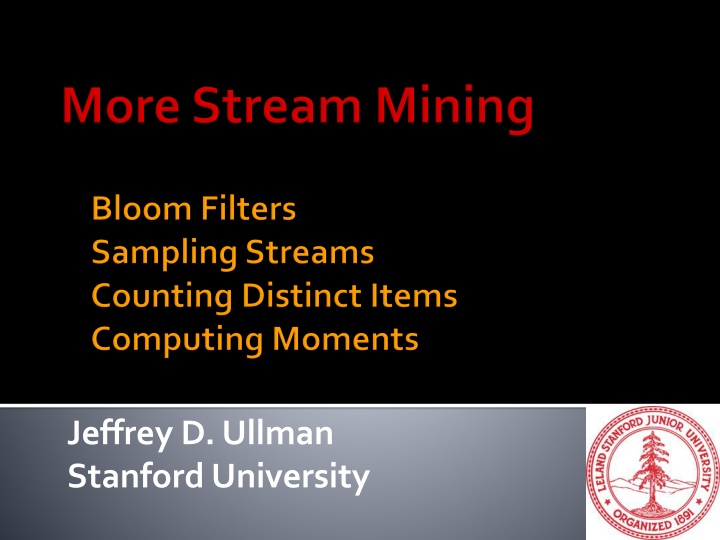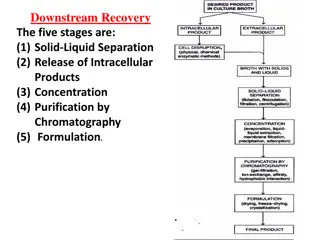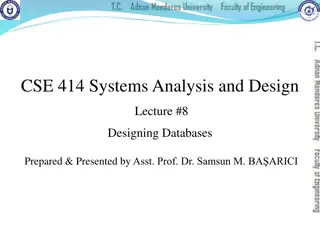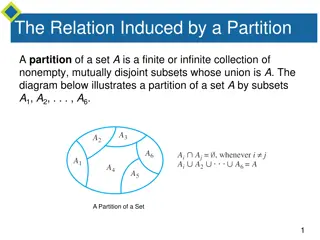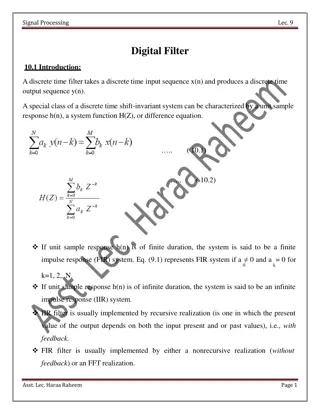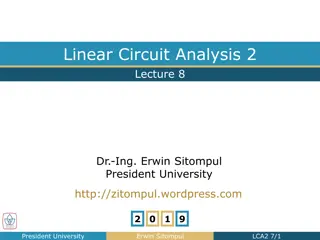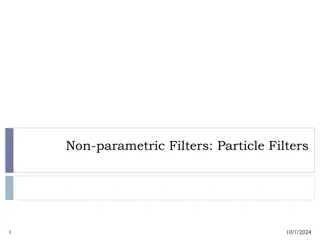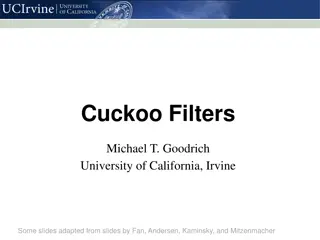Bloom Filters in Web Crawlers and Database Relations
Bloom filters are used in web crawlers and database relations to efficiently track seen or unseen URLs and values, minimizing chunk retrieval and enhancing search speed. Learn how Bloom filters work and manage false positives in different scenarios.
Download Presentation

Please find below an Image/Link to download the presentation.
The content on the website is provided AS IS for your information and personal use only. It may not be sold, licensed, or shared on other websites without obtaining consent from the author.If you encounter any issues during the download, it is possible that the publisher has removed the file from their server.
You are allowed to download the files provided on this website for personal or commercial use, subject to the condition that they are used lawfully. All files are the property of their respective owners.
The content on the website is provided AS IS for your information and personal use only. It may not be sold, licensed, or shared on other websites without obtaining consent from the author.
E N D
Presentation Transcript
Jeffrey D. Ullman Stanford University
To motivate the Bloom-filter idea, consider a web crawler. It keeps, centrally, a list of all the URL s it has found so far. It assigns these URL s to any of a number of parallel tasks; these tasks stream back the URL s they find in the links they discover on a page. It needs to filter out those URL s it has seen before. 2
A Bloom filter placed on the stream of URLs will declare that certain URL s have been seen before. Others will be declared new, and will be added to the list of URL s that need to be crawled. Unfortunately, the Bloom filter can have false positives. It can declare a URL seen before when it hasn t. But if it says never seen, then it is truly new. So we need to restart the filter periodically. 3
Suppose we have a database relation stored in a DFS, spread over many chunks. We want to find a particular value v, looking at as few chunks as possible. A Bloom filter on each chunk will tell us certain values are there, and others aren t. As before, false positives are possible. But now things are exactly right: if the filter says v is not at the chunk, it surely isn t. Occasionally, we retrieve a chunk we don t need, but can t miss an occurrence of value v. 4
A Bloom filter is an array of bits, together with a number of hash functions. The argument of each hash function is a stream element, and it returns a position in the array. Initially, all bits are 0. When input x arrives, we set to 1 the bits h(x), for each hash function h. 5
Use N = 11 bits for our filter. Stream elements = integers. Use two hash functions: h1(x) = Take odd-numbered bits from the right in the binary representation of x. Treat it as an integer i. Result is i modulo 11. h2(x) = same, but take even-numbered bits. 6
Stream element h1 Filter contents h2 00000000000 25 = 11001 5 2 00100100000 159 = 10011111 7 0 10100101000 585 = 1001001001 9 7 10100101010 Note: bit 7 was already 1. 7
Suppose element y appears in the stream, and we want to know if we have seen y before. Compute h(y) for each hash function y. If all the resulting bit positions are 1, say we have seen y before. We could be wrong. Different inputs could have set each of these bits. If at least one of these positions is 0, say we have not seen y before. We are certainly right. 8
Suppose we have the same Bloom filter as before, and we have set the filter to 10100101010. Lookup element y = 118 = 1110110 (binary). h1(y) = 14 modulo 11 = 3. h2(y) = 5 modulo 11 = 5. Bit 5 is 1, but bit 3 is 0, so we are sure y is not in the set. 9
Probability of a false positive depends on the density of 1 s in the array and the number of hash functions. = (fraction of 1 s)# of hash functions. The number of 1 s is approximately the number of elements inserted times the number of hash functions. But collisions lower that number slightly. 10
Turning random bits from 0 to 1 is like throwing d darts at t targets, at random. How many targets are hit by at least one dart? Probability a given target is hit by a given dart = 1/t. Probability none of d darts hit a given target is (1-1/t)d. Rewrite as (1-1/t)t(d/t) ~= e-d/t. ~= 1/e 11
Suppose we use an array of 1 billion bits, 5 hash functions, and we insert 100 million elements. That is, t = 109, and d = 5*108. The fraction of 0 s that remain will be e-1/2 = 0.607. Density of 1 s = 0.393. Probability of a false positive = (0.393)5 = 0.00937. 12
Suppose Google would like to examine its stream of search queries for the past month to find out what fraction of them were unique asked only once. But to save time, we are only going to sample 1/10th of the stream. The fraction of unique queries in the sample != the fraction for the stream as a whole. In fact, we can t even adjust the sample s fraction to give the correct answer. 14
The length of the sample is 10% of the length of the whole stream. Suppose a query is unique. It has a 10% chance of being in the sample. Suppose a query occurs exactly twice in the stream. It has an 18% chance of appearing exactly once in the sample. And so on The fraction of unique queries in the stream is unpredictably large. 15
My mistake: I sampled based on the position in the stream, rather than the value of the stream element. The right way: hash search queries to 10 buckets 0, 1, , 9. Sample = all search queries that hash to bucket 0. All or none of the instances of a query are selected. Therefore the fraction of unique queries in the sample is the same as for the stream as a whole. 16
Problem: What if the total sample size is limited? Solution: Hash to a large number of buckets. Adjust the set of buckets accepted for the sample, so your sample size stays within bounds. 17
Suppose we start our search-query sample at 10%, but we want to limit the size. Hash to (say) 100 buckets, 0, 1, , 99. Take for the sample those elements hashing to buckets 0 through 9. If the sample gets too big, get rid of bucket 9. Still too big, get rid of 8, and so on. 18
This technique generalizes to any form of data that we can see as tuples (K, V), where K is the key and V is a value. Distinction: We want our sample to be based on picking some set of keys only, not pairs. In the search-query example, the data was all key. Hash keys to some number of buckets. Sample consists of all key-value pairs with a key that goes into one of the selected buckets. 19
Data = tuples of the form (EmpID, Dept, Salary). Query: What is the average range of salaries within departments? Key = Dept. Value = (EmpID, Salary). Sample picks some departments, has salaries for all employees of that department, including its min and max salaries. Result will be an unbiased estimate of the average salary range. 20
Problem: a data stream consists of elements chosen from a set of size n. Maintain a count of the number of distinct elements seen so far. Obvious approach: maintain the set of elements seen. 22
How many different words are found among the Web pages being crawled at a site? Unusually low or high numbers could indicate artificial pages (spam?). How many unique users visited Facebook this month? How many different pages link to each of the pages we have crawled. Useful for estimating the PageRank of these pages. Which in turn can tell a crawler which pages are most worth visiting. 23
Real Problem: what if we do not have space to store the complete set? Or we are trying to count lots of sets at the same time. Estimate the count in an unbiased way. Accept that the count may be in error, but limit the probability that the error is large. 24
Pick a hash function h that maps each of the n elements to at least log2n bits. For each stream element a, let r(a) be the number of trailing 0 s in h(a). Called the tail length. Record R = the maximum r(a) seen for any a in the stream. Estimate (based on this hash function) = 2R. 25
The probability that a given h(a) ends in at least i 0 s is 2-i. If there are m different elements, the probability that R i is 1 (1 - 2-i)m. Prob. a given h(a) ends in fewer than i0 s. Prob. all h(a) s end in fewer than i 0 s. 26
-i Since 2-i is small, 1 - (1-2-i)m 1 - e-m2 . If 2i >> m, 1 - e-m2 1 - (1 - m2-i) m/2i 0. If 2i << m, 1 - e-m2 1. Thus, 2R will almost always be around m. -i -i First 2 terms of the Taylor expansion of ex Same trick as throwing darts. Multiply and divide m by 2-i. 27
E(2R) is, in principle, infinite. Probability halves when R -> R+1, but value doubles. Workaround involves using many hash functions and getting many samples. How are samples combined? Average? What if one very large value? Median? All values are a power of 2. 28
Partition your samples into small groups. O(log n), where n = size of universal set, suffices. Take the average within each group. Then take the median of the averages. 29
If there is an edge between nodes u and v, then u is a neighbor of v and vice-versa. The neighborhood of node u at distance d is the set of all nodes v such that there is a path of length at most d from u to v. Denoted n(u,d). Notice that if there are N nodes in a graph, then n(u,N-1) = n(u,N) = n(u,N+1) = = all nodes reachable from u. 31
A B D E C G F n(E,0) = {E}; n(E,1) = {D,E,F}; n(E,2) = {B,D,E,F,G}; n(E,3) = {A,B,C,D,E,F,G}. 32
The sizes of neighborhoods of small distance measure the influence a person has in a social network. Note it is the size of the neighborhood, not the exact members of the neighborhood that is important here. 33
n(u,0) = {u} for every u. n(u,d) is the union of n(v, d-1) taken over every neighbor v of u. Not really feasible for large graphs, since the neighborhoods get large, and taking the union requires examining the neighborhood of each neighbor. To eliminate duplicates. Note: Another approach where we take the union of neighbors of members of n(u, d-1) presents similar problems. 34
The idea behind Flajolet-Martin lets you estimate the number of distinct elements in the union of several sets. Pick several hash functions; let h be one. For each node u and distance d compute the maximum tail length among all nodes in n(u,d), using hash function h. 35
Remember: if R is the maximum tail length in a set of values, then 2R is a good estimate of the number of distinct elements in the set. Since n(u,d) is the union of all neighbors v of u of n(v,d-1), the maximum tail length of members of n(u,d) is the largest of 1. The tail length of h(u), and 2. The maximum tail length for all the members of n(v,d-1) for any neighbor v of u. 36
Thus, we have a recurrence (on d) for the maximum tail length of any neighbor of any node u, using any given hash function h. Repeat for some chosen number of hash functions. Combine estimates to get an estimate of neighborhood sizes, as for the Flajolet-Martin algorithm. 37
Suppose a stream has elements chosen from a set of n values. Let mi be the number of times value i occurs. The kthmoment is the sum of (mi)k over all i. 39
0th moment = number of different elements in the stream. The problem just considered. 1st moment = sum of counts of the numbers of elements = length of the stream. Easy to compute. 2nd moment = surprise number = a measure of how uneven the distribution is. 40
Stream of length 100; 11 values appear. Unsurprising: 10, 9, 9, 9, 9, 9, 9, 9, 9, 9, 9. Surprise # = 910. Surprising: 90, 1, 1, 1, 1, 1, 1, 1 ,1, 1, 1. Surprise # = 8,110. 41
Works for all moments; gives an unbiased estimate. We ll talk about only the 2nd moment. Based on calculation of many random variables X. Each requires a count in main memory, so number is limited. 42
Assume stream has length n. Pick a random time to start, so that any time is equally likely. Let the chosen time have element a in the stream. X = n * ((twice the number of a s in the stream starting at the chosen time) 1). Note: store n once, store count of a s for each X. 43
2nd moment is a(ma)2. E(X) = (1/n)( all times tn * (twice the number of times the stream element at time t appears from that time on) 1). = a (1/n)(n)(1+3+5+ +2ma-1). = a (ma)2. Time when penultimate a is seen Group times by the value seen Time when the first a is seen Time when the last a is seen 44
We assumed there was a number n, the number of positions in the stream. But real streams go on forever, so n changes; it is the number of inputs seen so far. 45
1. The variables X have n as a factor keep n separately; just hold the count in X. 2. Suppose we can only store k counts. We cannot have one random variable X for each start-time, and must throw out some start- times as we read the stream. Objective: each starting time t is selected with probability k/n. 46
Choose the first k times for k variables. When the nth element arrives (n > k), choose it with probability k/n. If you choose it, throw one of the previously stored variables out, with equal probability. Probability of each of the first n-1 positions being chosen: (n-k)/n * k/(n-1) + k/n * k/(n-1) * (k-1)/k = k/n n-th position not chosen Previously chosen n-th position chosen Previously chosen Survives 47
Thus, each variable has the second moment as its expected value. Use many (e.g., 100) such variables. Combine them as for Flajolet-Martin: average of groups of size O(log n), and then take the median of the averages. 48
